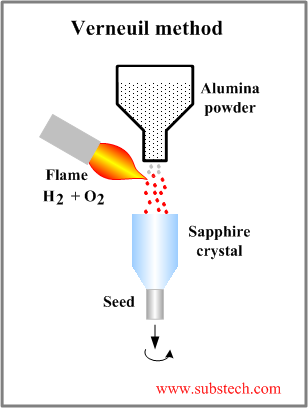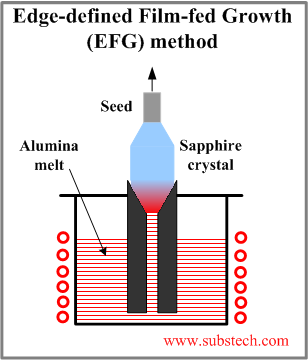Main page
About us
Sliding Bearings Consulting
Advertising Opportunities

to Ceramics
to Oxide ceramics
Synthetic sapphire
Dr. Dmitri Kopeliovich
Sapphire is alpha alumina (α-AL2O3, hexagonal alumina) in the monocrystalline form.
Properties and applications of synthetic sapphire
Sapphire is used in a wide range of applications due to its unique combination of optical, mechanical, chemical, dielectric and thermal properties:
- High hardness (9 in Mohs Scale).
- High strength.
- High stiffness.
- Excellent wear resistance.
- High refractoriness.
- High resistance to chemical attacks of strong acids and alkali even at high temperatures.
- Excellent insulating properties.
- Good thermal conductivity.
- High refractive index.
- Good biocompatibility.
Typical applications of synthetic sapphires:
- High strength and erosion resistant windows for aerospace industry, watches, etc.
- High pressure, high temperature chambers of analytic devices (spectroscopes, Nuclear Magnetic Resonance, Inductively Coupled Plasma analysis)
- Substrate for silicon base Integrated Circuits.
- Substrate for growing gallium nitride (GaN) used in semiconductor industry.
- Optical devices for Ultraviolet and Infrared applications.
Verneuil method
 A growth of synthetic sapphire from alumina melt was invented by August Verneuil in 1904.
A growth of synthetic sapphire from alumina melt was invented by August Verneuil in 1904.
The technique is known as Verneuil method or Flame fusion method.
In Verneuil method alumina powder is passing through a Hydrogen-Oxygen flame where it is fused and falls on liquid pool (meniscus) on the top of the solidifying crystal.
The Crystallization process starts on a small seed of an oriented sapphire single crystal.
The first stage is a formation of a neck, which is then enlarges.
The growing crystal is pulled down at a speed determined by the rate of solidification.
The method allows to produce sapphire crystals with a diameter up to 2.4” (60 mm).
The crystals grown by Verneuil method may contain inclusions and other voids.
Sapphire crystals produced by the method were used in jewelry and watch industry.
to top
Czochralski method
 The process of a single crystal growth has been considerably improved by Czochralski.
The process of a single crystal growth has been considerably improved by Czochralski.
In Czochralski method (1918) the sapphire crystal is formed from a molten alumina contained in a refractory crucible.
Like in other sinle crystal growth techniques the crystallization process starts on the surface of a small crystal seed.
The seed is mounted in a lower tip of a water cooled rod. In the beginning the rod with the seed is dipped into the melt. Then the rod starts to move up at a speed determined by the Crystallization rate.
At the same time the rod with the solidified crystal is rotating. The rotation provides homogeneous distribution of the melt temperature in the region of the solidification front.
The growing sapphire crystal is connected to the melt by means of surface tension force.
The diameter of the crystal is controlled by the rate of the heat extraction and the pulling speed.
The temperature gradient in the growing crystal causes a formation of internal stresses, which however may be relieved by an annealing heat treatment.
High crystalline quality sapphire crystals (bouls) with a diameter up to 8” (150) mm and the length up to 10” (250 mm) may be grown by Czochralski method.
to top
Kyropoulos method
 Kyropoulos method (1926) is somewhat similar to Czochralski technique.
Kyropoulos method (1926) is somewhat similar to Czochralski technique.
It also starts from the contact of a seed crystal mounted in the holder with a molten alumina.
However the Crystallization front in a crystal pulled by Czochralski method is a meniscus located in the column connecting the surface of the molten alumina with the growing crystal.
In Kyropoulos technique the growing crystal is surrounded by the melt. The crystal growth occurs within the crucible with the molten alumina.
The crystal grows until its surface reaches the crucible walls. Then the crystal is pulled out (lifted) and the growing cycle repeats. There is also a version of the process with continuous pulling the crystal from the crucible.
The diameter of the crystal grown by Kyropoulos method is limited by the diameter of the crucible.
The main advantage of Kyropoulos method is the crystallization at low temperature gradients - below 45ºF/inch (10ºC/cm) , which results in low thermal stresses in the crystal.
High optical quality large crystals (bouls) with diameter exceeding 14” (350 mm) may be produced by Kyropoulos method.
to top
Edge-defined Film-fed Growth (EFG) method
 In Edge-defined Film-fed Growth (EFG) method the molten alumina is driven up to the Crystallization front by the capillary forces within a die with thin channels (capillary die).
In Edge-defined Film-fed Growth (EFG) method the molten alumina is driven up to the Crystallization front by the capillary forces within a die with thin channels (capillary die).
The crystallization of the melt occurs on the top of the die (exit of the capillary channel) in an inert (Argon) atmosphere.
The crystal is continuously pulled out upwards at a rate 0.4-1.6 inch/hr (1-4 cm/hr).
The alumina fibers are grown at a speed up to 0.8 “/min (20 cm/min).
Thin wall cross section near-net-shape crystals of may be grown by EFG method:
- Ribbons up to 6” (150 mm) width;
- Tubes up to 3.4” (85 mm) diameter;
- Crucibles up to 3.2” (80 mm) diameter;
- Rods;
- Fibers of 0.004”-0.02” (100-500 µm) diameter.
Horizontal Directed Crystallization (HDC) method
 Horizontal Directed Crystallization (HDC) method was developed by Bagdasarov in 1975.
Horizontal Directed Crystallization (HDC) method was developed by Bagdasarov in 1975.
In HDC technique a sapphire crystal growth horizontally in a boat shape container with molten alumina.
The molybdenum container with alumina is initially placed in a rectangular heater. A crystal seed is mounted in the corner of the “boat”.
The container is slowly pulled out of the heater causing the molten alumina to crystallize. The crystal forms in the boat itself.
The pulling rate is 0.3-0.4 “/hr (8-10 mm/hr).
HDC method is relatively simple and allows to grow crystals at low temperature gradient.
Sapphire crystals of very high optical quality, low thermal stress and different crystallographic orientation are fabricated by Horizontal Directed Crystallization (HDC) method. The typical dimensions of the slab grown by the technique is 10”x10”x1” (250x250x25 mm).
to top
Related internal links


